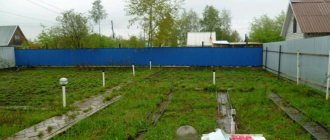According to the study: there are 300-400 cars per 1000 residents of the Russian metropolis, the number of vehicles is increasing every year. If you think about it, out of 24 hours of the earth’s day, most of the time a personal vehicle is not in motion, but in a parking lot. Based on the above facts, the significance and relevance of the problem of “storing” personal cars in the modern urban environment becomes obvious.
Dense urban development and lack of parking spaces make it difficult to manage the city's transport infrastructure. In addition, the increase in the number of cars and the increase in parking areas significantly “degrade” the urban landscape, making it visually broken, fragmented and unaesthetic. Today, during the construction of buildings, structures, their restoration, and landscaping, special attention should be paid to the efficient use of space.
Defining a parking lot
The parking area is a fenced part of the road space, which is indicated by markings and a special sign. According to the Traffic Rules, parking zones are designated by the letter “P”. This image is for informational purposes only and is most often used in conjunction with other instructions (for example, about how to park a vehicle).
Places for temporary parking of a car can be provided:
- paid;
- free of charge.
To park for free, vehicles can be left in public areas (in open areas, areas, near shopping centers specially equipped for such areas). Paid car parking can be installed at the entrances to strategically important objects (airports, railway stations), or to private protected areas.
Reference. Long-term parking services are provided for a fee near shopping centers and are accompanied by security or video surveillance.
Staying in the parking zone can last for a few minutes or for months, if the rules for leaving a car in a specific zone allow the car to be placed under guard. In the latter case, the parking lot will have the status of a parking lot and will be regulated by special rules for the provision of long-term car storage services.
Description of equipment:
A corner damper is installed to protect the corners of walls, columns, protruding elements of buildings and structures, as well as to prevent damage to vehicles when opening doors and during maneuvering.
The wall damper is used to mark and protect the walls and body of the vehicle. Thanks to reflective elements, it can be used to indicate the direction of movement.
A deliniator (wheel guard) is necessary for organizing traffic; it is installed to restrict the entry of vehicles into the territory and mark parking spaces. It can also act as a protection for buildings, structures and vehicles from damage.
Parking bollards are often used in addition to road markings to separate traffic lanes, mark dangerous turns and obstacles, and organize temporary fencing.
Artificial road humps (ARH) or speed bumps are installed to force the speed of vehicles to decrease.
Parking for disabled people
In some cases, when delimiting places for long stops, it is necessary not only to pay attention to the scale of transport, but also to which driver will use the parking services.
Special attention both on the road and in parking areas is paid to such a category of citizens as people with disabilities. It is they who often need additional space that would allow them to freely get out of the car in the parking lot, use available means (strollers) and not experience discomfort when passing through areas crowded with vehicles. Therefore, the size of a parking space for disabled people is separately specified by state standards and for a passenger car is:
- 3.60 m wide;
- 6.20 m long.
An error is allowed for such figures, but not more than 5 cm.
Important! Requirements for leaving cars for groups of the population with disabilities are established in the Code of Rules 59.13330.2012, as well as GOST standards 51256-2011.
In order to prevent other persons from leaving vehicles in such specially equipped parking lots, the disabled parking area is usually marked not only with the “P” sign, but also with an informational “Disabled” sign. If other citizens place their car in such a parking lot, the latter will have to pay a fine of 5,000 rubles.
Features of sites with different surfaces
Coarse sand or fine granite chips (1-4 mm) are poured under paving slabs, bricks, flagstones, rubber tiles. Please note that for car parking, tiles need to be at least 50 mm (for paths, you can take from 30 mm). One more point: the smaller the size of the tiles used to pave the parking lot at the dacha, the less noticeable will be the inevitable “game” of the levels of the bricks.
Different coatings for summer cottage parking lots have their own installation characteristics.
Natural stone and concrete slabs
If you decide to make a parking lot from natural stone cut into slabs, it should also be 4-5 cm thick. You should not lay too large pieces: there is a high probability that they will break. They should not be placed closely, but leaving gaps of a couple of millimeters. The gaps are filled with sand, to which you can add abrasion-resistant lawn grass seeds. If you make the same paths, it will turn out beautifully, organically, and there will be no dirt.
With natural stone everything looks very decent
If the grass doesn’t appeal to you (it’s more difficult to clean, you have to cut it somehow), fill the gaps between the slabs with a mixture of sand and cement (1 part cement, 3 parts sand). Sweep it off the stones so that there is nothing on them and water the area (not with a stream, but with small drops, and so that it does not flow). The mixture will turn into concrete. It will take a certain amount of time to gain strength: 7 days at a temperature of +20°C to achieve 50% strength and another two weeks for complete “ripening”. Until the strength reaches 50%, it is advisable that there are no rainfalls during this period, and if they start, cover the area with polyethylene. Water itself is not scary, but streams that can wash away fragile concrete are scary.
This option has only one drawback: the high price of the stone. To reduce costs, you can use ready-made paving slabs in large format: 50*50 cm or so. They are also laid on a gravel-sand bed. Everything is the same, only the slabs are of artificial origin and have a clear geometry.
Concrete
For a concrete site, you will need to install formwork around the perimeter. Then you will need to make a reinforcing frame in the form of a cage from a metal rod. A rod with a diameter of 10-15 mm is taken, a lattice is folded from it in increments of 10-15 cm, and tied at the joints with a special wire (knitting). The resulting mesh is placed on stops so that it is raised above the compacted crushed stone by 3-5 cm, and the layer of concrete on top should also be at least 10 cm (preferably 15).
If a concrete parking lot at a dacha is made for two or more cars, expansion joints will be required. To do this, wooden planks 0.7-1 cm thick are laid edgewise on a grid of reinforcement. The width of the planks is equal to the height of the concrete layer (they can be used as guides when leveling the concrete mixture). They are laid in increments of 2 meters.
Concrete parking for a car at the dacha in the process of being manufactured
In the case of concrete, you will have to wait quite a long time for your parking lot to start using. The concrete must stand for at least 28 days. And this is if the temperature does not drop below +20°C. At the same time, you need to ensure that the surface does not dry out. To do this, you need to water the area, and to prevent the water from drying out quickly, throw matting, old bags, etc. on top, throw a piece of polyethylene on top. This coating helps maintain humidity, equalizes temperature (local overheating is harmful) and protects the surface from drops that are inevitable when watering.
If you can’t wait that long, add an “accelerator” to the concrete. An additive that accelerates the hardening of concrete. The period may be reduced to 7-10 days. But carefully read the features of caring for such concrete.
Green lawn parking
When constructing a green parking lot, special grates are placed on a layer of gravel, the gaps of which are filled with fertile soil and sown with grass seeds. To park a passenger car, and sometimes even a jeep, a grate with a height of 10 cm is sufficient. If heavy vehicles (trucks with materials) are to be placed on the site for unloading, a grate is needed with a height of at least 15 cm.
The difference in the cost of gratings for green parking is significant. But the difference in price is usually justified: some eco-parking lots do not sag and look normal, while others crumple, turning the surface into a mess of soil and grass. Therefore, when choosing gratings, do not go for cheapness.
Lawn parking for cars at the dacha
Taking care of a grass parking lot is not very convenient: the rake gets stuck in the grate, and not every lawn mower can operate safely. Therefore, many owners of such sites are disappointed. But recently, another trend has appeared - instead of soil and grass, medium crushed stone is poured into the grates, and the top is covered with small crushed stone or pebbles. How is this option better than a regular bulk site? The platform is not pressed under the wheels of even a heavily loaded vehicle. This option is ideal for clay soils.
Garage for 2 cars: optimal sizes and device options
When planning the construction of a garage for two cars, many proceed from the mathematical equality 1+1=2.
However, simply summing up the dimensions of the machines to create a convenient box is not enough. Only after thinking through all the related tasks that this structure will help you solve can you begin to draw up a project. What issues does the owner need to resolve before a two-car garage is built?
There are many of them:
- Optimal room sizes (convenient parking, vehicle inspection and maintenance);
- Possibility of storing tires, tools and household equipment;
- Number, dimensions and type of entrance gates (swing, sliding, up-and-over);
- The need to combine a garage with a house, utility room or bathhouse;
- Wall material (brick, foam blocks, sandwich, timber);
- Floor type (reinforced concrete panels, monolithic concrete, wooden beams);
- Type of roof (attic, hipped or pitched).
Before and after parking arrangement
Move the slider to the side to evaluate how the area has changed after the car parking was installed. You will see different parking options at the dacha.
Parking lot made from used road slabs
Crushed stone parking lot
Concrete parking lot
Paving a car area
Parking lot made of lawn grids (eco-parking)
Parking with canopy
When the owners come to the dacha for a long time, it makes sense to build a canopy over the open area. You should not install it high, in such a situation the canopy will turn into a sail. It will be shaken by the wind, and the car itself will remain accessible to side precipitation. To determine the correct height, experts recommend using the formula (the height of the car plus the height of the possible load on its top). On average, it turns out to be 2-2.5 m. Canopies are usually installed as follows.
A concrete base is also installed, support pillars are installed immediately, if tile material is used to arrange the parking lot, the supports are pre-concreted, and only then the base is poured.
Parking at the dacha with a canopy made using wooden beams Source yastroyu.ru
Construction of a dacha parking area: preparatory work
Despite the different surfaces for parking a car at the dacha, the preparatory work is not much different. The difference may be in the layer on which the coating is laid (for example, you need to pour a layer of sand when paving with paving slabs), but the whole pie and the list of other works are the same.
You can do this... until you get stuck after the rain
General recommendations
The first thing you need to decide on is the location. The parking lot at the dacha is usually located either right next to the gate or not far from it. And it makes sense. But this zone should not be the lowest point, otherwise water will constantly stagnate here, and a height difference here is also undesirable - putting the car on the handbrake and putting on chocks is not exactly what you want.
The best way to compact sand and gravel is to use a plate compactor. If you don’t have one, you can make a homemade tamper. Take a log, attach handles, and attach a strong platform (thick board) to the bottom. By lifting and sharply throwing this tool, you compact the sand/crushed stone
At the same time, solid surfaces such as concrete or asphalt should not be brought to zero level: water after washing a car or rain will not drain away. To prevent it from stagnating, it will be necessary to form a slight slope - from the center to the edges. A slope of a couple of degrees is already good. And the car will stand stable, and the water will drain.
Dimensions
The dimensions of a country parking lot depend on the planned number of cars “living” there. A plot of 3*5 meters is enough for one car, i.e. 15 m². This space is quite enough to not have to think about parking exactly in the center, otherwise you will have to go out onto the lawn, into a flower bed, etc. Parking at a dacha of such an area makes it possible to calmly walk around the car in front and behind.
If space is limited, the length can be reduced by 0.5 m, but with this size you can walk either in front of the car or behind it. Only if you have a large-sized jeep, it is better to increase the width of the platform by at least 50 cm, and even better - by a meter. These machines are large and require more space.
Parking lot sizes: this picture is from SNiP (building codes and regulations)
If you need to park two cars and they are “standard” sizes, the comfortable parking length at the dacha remains the same - 5 m. If there is enough space, we take the same width as 3 meters. That is, to park two cars you will need a site measuring 5*6 m (5 meters is the length). If there is a shortage of space, the width and length can be reduced by 0.5 meters (4.5 * 5.5). But in this case, it will not be possible to open the car doors at the same time and it will also be difficult to walk around the car.
Car entry: water drainage
The next step is to decide whether you need drainage around the parking lot at your dacha or not. If the soil drains water well naturally and the surface is not continuous (tiles, lawn, stone), it is quite possible to do without drainage measures. If at least one of the conditions is absent, drainage will have to be done. There are many options, but there are three simplest ones:
- If the water on the site usually does not stagnate, the perimeter of the site with a continuous coating (concrete, asphalt, rubber tiles) is sprinkled with crushed stone 30-40 cm wide. The water drains, enters the crushed stone floor and gradually goes into the ground.
- If a drainage system is installed on the site, drainage pipes are laid around the perimeter (10 cm below the coating level, cover the top with crushed stone, pebbles, mulch, sand, plant a lawn). These pipes are inserted into the general drainage system (do not forget to make a couple of inspection hatches for cleaning.







